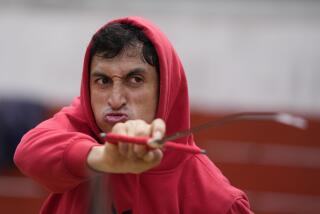Petition Drive Aims to Ban National Sport : Activists Target Spain’s Sacred Cow: Bullfights
- Share via
MADRID — Ban bullfighting in Spain? It’s as if someone wanted to ban baseball in the United States.
But a group of Spaniards, nevertheless, wants to put an end to what it sees as cruelty in the bullring.
The Spanish Animal Rights Assn. and several European Parliament deputies have launched a Europe-wide petition drive calling on governments to adopt legislation that would ban bullfighting in Spain and France and fox hunting in Britain, France and Ireland.
The petition, which organizers hope will carry half a million signatures, is to be given to Prime Minister Felipe Gonzalez of Spain in January in Brussels, shortly after Spain assumes the rotating presidency of the European Economic Community.
Broader Scope
Although organizers want animal protection legislation passed in all 12 EEC member states, the petition is aimed specifically at ending or “modernizing” bullfighting in Spain and doing away with the torturing or killing of animals during many traditional religious festivals around the country.
Making bullfighting “modern” or acceptable to opponents would involve eliminating the picadors on horseback who lance the bull to weaken its neck muscles so that its head goes down, the banderilleros who spike the animal’s neck muscles with three pairs of long darts, and the final act--the moment of truth--when the matador stabs the bull between the shoulder blades and through the heart.
In neighboring Portugal, the bull is picked lightly by a bullfighter on horseback, then grabbed by the tail by a group of men called forcados and wrestled around until it is dazed. The bull does not die in the ring but is slaughtered shortly afterward in packinghouse fashion.
The proposed legislation would also eliminate the use of horses during bullfights, prohibit young people from attending and force televised fights into a late-night time slot when children are in bed.
Carlos Briones, a spokesman for the Ministry of Interior which oversees bullfighting, said the government had no official comment on the subject.
Engrained in Culture
But Briones said he personally feels bullfighting is part of Spanish culture and should be maintained.
Bullfighting is considered an art rather than a sport in Spain.
This past season, 23 million people attended bullfights in Spain--3 million more than 1987. The capitals of 49 of Spain’s 52 provinces have permanent bullrings, and during the summer months portable rings are set up in thousands of towns and villages for their annual fiestas.
The number of major fights rose 11% this year to 566, the highest number in the last decade.
A first-class bullfighter earns from $27,000 to $35,000 to fight three bulls in an afternoon during the big fiestas in Madrid, Seville, Bilbao, Pamplona, Zaragoza, Malaga and Valencia.
Spain’s leading bullfighter of the moment, Espartaco, fought 82 corridas --three-bull afternoons--during the last season.
Bullfighting and animal sacrifice in religious festivals are centuries-old traditions in Spain. Dona Mercedes de Borbon, the mother of King Juan Carlos I, is an avid bullfight aficionada, and the king occasionally makes an appearance at Madrid’s Las Ventas ring, the world’s largest.
Limited Ban in Catalonia
Last year, the government of the autonomous region of Catalonia in northeastern Spain banned the torturing and sacrificing of animals in religious festivals but still permits bullfighting.
The Spanish Animal Rights Assn., which claims 2,000 members and 8,000 contributors, says Spain is the only EEC country that does not consider mistreatment of animals a criminal offense.
The association’s vice president, Consuelo Polo, said there has been a resurgence of ritualistic street festivals since the death in 1975 of Gen. Francisco Franco, who banned animal taunting and sacrifice during his 36 years of authoritarian rule.
“They don’t think it’s a fiesta unless they have bulls running through the streets,” she said.
On most Sundays during the bullfighting season--March to October--association members stand outside bullrings, at Madrid’s Prado Museum and on the southern Costa del Sol beaches handing out literature in an effort to discourage tourists from attending bullfights.
But Pedro Geraldo, a bullfighter for 14 years, says Spaniards respect not only the bullfighters but also the bulls for courage and beauty.
“It’s an art that is sometimes misunderstood by foreigners,” he said.
More to Read
Sign up for Essential California
The most important California stories and recommendations in your inbox every morning.
You may occasionally receive promotional content from the Los Angeles Times.













